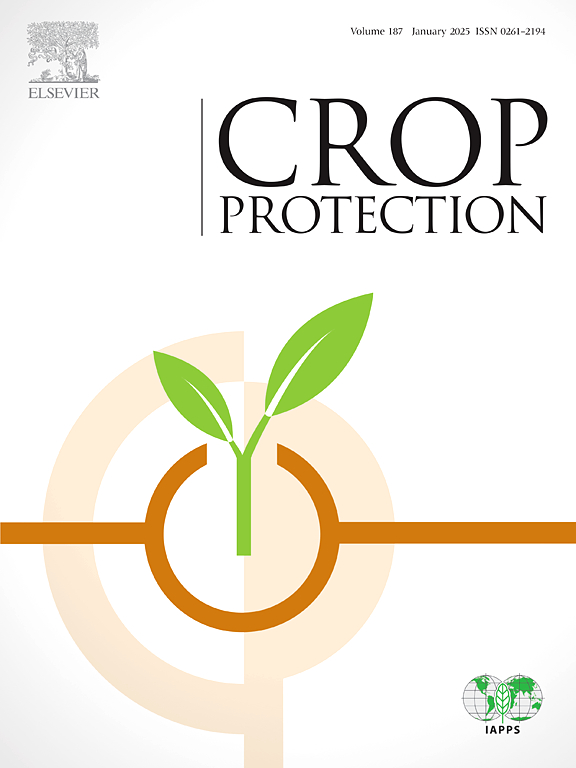验证纽约州 Delia platura 首次出现的度日阈值
IF 2.5
2区 农林科学
Q1 AGRONOMY
引用次数: 0
摘要
籽粒蛆(Delia platura)是一种分布于全球的农业害虫,以玉米和豆类等重要经济作物的发芽种子为食。幼虫造成地下危害,可能导致作物减产。几十年来,D. platura 一直使用杀虫剂包衣的种子进行管理,但在纽约州禁止使用新烟碱包衣的玉米、大豆和小麦种子后,这种做法将不再适用。自 20 世纪末以来,度日模型一直被用于预测农业害虫越冬代的出现。然而,文献中用于区分首次萌发和萌发高峰的度日阈值的术语并不明确,而且之前关于 360 度日萌发阈值的报告与实地观测结果并不一致。2023 年,我们在纽约州的四个地点捕捉到了首次萌发;2024 年,我们在纽约州的 25 个地点监测到了 D. platura 成虫。以 1 月 1 日为生物固定期,我们在 52 到 197 个累积度日(98 ± 7 度日,平均值 ± 1 SE)之间观察到首次成虫出现,这证实在纽约州,D. platura 出现的时间早于之前报告的数值。此外,我们注意到 2023 年 12 月和 2024 年 1 月期间的成虫活动,这表明冬季变暖可能会影响我们预测害虫出现的能力。我们建议未来的模型应结合度日信息和其他已知会影响害虫的地区特定因素,包括农场管理、土壤条件和景观构成,以进行更准确的预测。本文章由计算机程序翻译,如有差异,请以英文原文为准。
Validation of degree day threshold for Delia platura first emergence in New York State
Seedcorn maggot (Delia platura) is a globally distributed agricultural pest that feeds on the germinating seeds of economically important crops, including corn and beans. The larvae cause underground damage, which can lead to stand loss. For decades, D. platura has been managed using insecticide-coated seeds, but following the ban on neonicotinoid-coated corn, soy, and wheat seeds in New York State, this practice will no longer be available. Degree day models have been used to predict the emergence of the overwintering generation of agricultural pests since the late 1900s. However, the terminology used in the literature to distinguish degree day thresholds for first emergence and peak emergence is unclear, and previous reports of a 360 degree day emergence threshold did not align with field observations. In 2023, we captured the first emergence at four sites, and in 2024, we monitored adult D. platura at 25 sites in New York State. We observed the first adult emergence between 52 and 197 accumulated degree days (98 ± 7 degree days, mean ± 1 SE) using a biofix of January 1st, confirming that in New York State, D. platura emergence is earlier than previously reported values. Additionally, we note adult activity during December 2023 and January 2024, suggesting that warming winters may impact our ability to predict pest emergence. We propose future models should incorporate both degree day information and other regionally specific factors known to impact pests, including farm management, soil conditions, and landscape composition, for more accurate predictions.
求助全文
通过发布文献求助,成功后即可免费获取论文全文。
去求助
来源期刊

Crop Protection
农林科学-农艺学
CiteScore
6.10
自引率
3.60%
发文量
200
审稿时长
29 days
期刊介绍:
The Editors of Crop Protection especially welcome papers describing an interdisciplinary approach showing how different control strategies can be integrated into practical pest management programs, covering high and low input agricultural systems worldwide. Crop Protection particularly emphasizes the practical aspects of control in the field and for protected crops, and includes work which may lead in the near future to more effective control. The journal does not duplicate the many existing excellent biological science journals, which deal mainly with the more fundamental aspects of plant pathology, applied zoology and weed science. Crop Protection covers all practical aspects of pest, disease and weed control, including the following topics:
-Abiotic damage-
Agronomic control methods-
Assessment of pest and disease damage-
Molecular methods for the detection and assessment of pests and diseases-
Biological control-
Biorational pesticides-
Control of animal pests of world crops-
Control of diseases of crop plants caused by microorganisms-
Control of weeds and integrated management-
Economic considerations-
Effects of plant growth regulators-
Environmental benefits of reduced pesticide use-
Environmental effects of pesticides-
Epidemiology of pests and diseases in relation to control-
GM Crops, and genetic engineering applications-
Importance and control of postharvest crop losses-
Integrated control-
Interrelationships and compatibility among different control strategies-
Invasive species as they relate to implications for crop protection-
Pesticide application methods-
Pest management-
Phytobiomes for pest and disease control-
Resistance management-
Sampling and monitoring schemes for diseases, nematodes, pests and weeds.
 求助内容:
求助内容: 应助结果提醒方式:
应助结果提醒方式:


